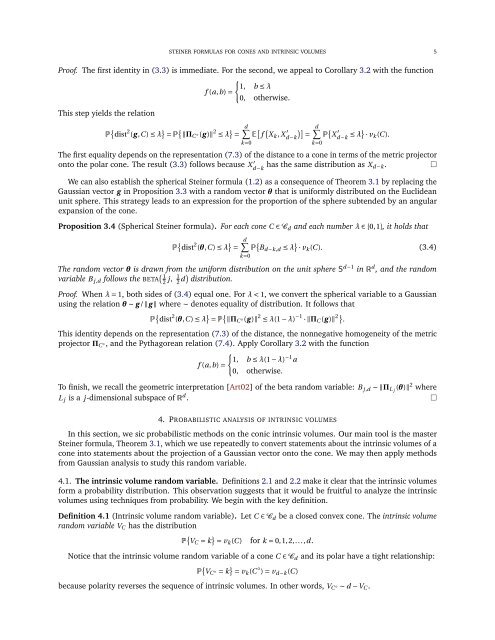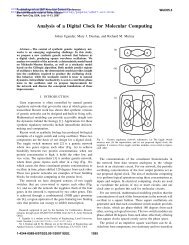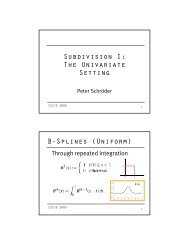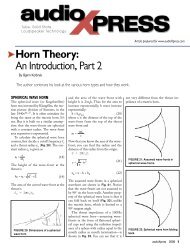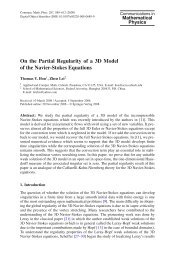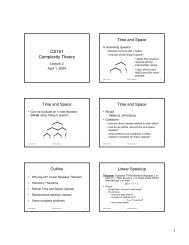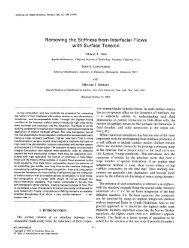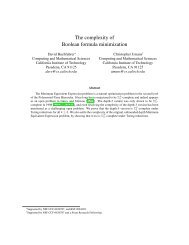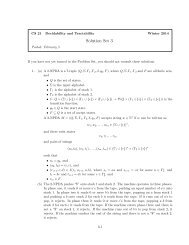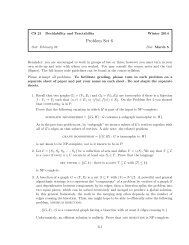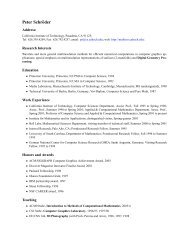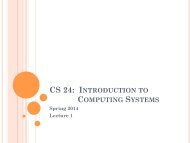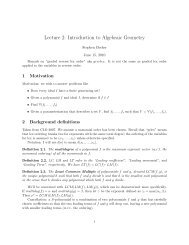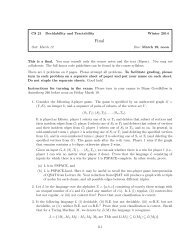From Steiner formulas for cones to concentration of intrinsic volumes
From Steiner formulas for cones to concentration of intrinsic volumes
From Steiner formulas for cones to concentration of intrinsic volumes
Create successful ePaper yourself
Turn your PDF publications into a flip-book with our unique Google optimized e-Paper software.
STEINER FORMULAS FOR CONES AND INTRINSIC VOLUMES 5Pro<strong>of</strong>. The first identity in (3.3) is immediate. For the second, we appeal <strong>to</strong> Corollary 3.2 with the function{1, b ≤ λf (a,b) =0, otherwise.This step yields the relationP { dist 2 (g ,C) ≤ λ } = P { ‖Π C ◦(g )‖ 2 ≤ λ } =d∑E [ f ( X k , X ′ )] d∑d−k = P { X ′ d−k ≤ λ} · v k (C).k=0The first equality depends on the representation (7.3) <strong>of</strong> the distance <strong>to</strong> a cone in terms <strong>of</strong> the metric projec<strong>to</strong>ron<strong>to</strong> the polar cone. The result (3.3) follows because X ′ d−k has the same distribution as X d−k.□We can also establish the spherical <strong>Steiner</strong> <strong>for</strong>mula (1.2) as a consequence <strong>of</strong> Theorem 3.1 by replacing theGaussian vec<strong>to</strong>r g in Proposition 3.3 with a random vec<strong>to</strong>r θ that is uni<strong>for</strong>mly distributed on the Euclideanunit sphere. This strategy leads <strong>to</strong> an expression <strong>for</strong> the proportion <strong>of</strong> the sphere subtended by an angularexpansion <strong>of</strong> the cone.Proposition 3.4 (Spherical <strong>Steiner</strong> <strong>for</strong>mula). For each cone C ∈ C d and each number λ ∈ [0,1], it holds thatP { dist 2 (θ,C) ≤ λ } =k=0d∑P { B d−k,d ≤ λ } · v k (C). (3.4)k=0The random vec<strong>to</strong>r θ is drawn from the uni<strong>for</strong>m distribution on the unit sphere S d−1 in R d , and the randomvariable B j,d follows the ( 1BETA2 j, 12 d) distribution.Pro<strong>of</strong>. When λ = 1, both sides <strong>of</strong> (3.4) equal one. For λ < 1, we convert the spherical variable <strong>to</strong> a Gaussianusing the relation θ ∼ g /‖g ‖ where ∼ denotes equality <strong>of</strong> distribution. It follows thatP { dist 2 (θ,C) ≤ λ } = P { ‖Π C ◦(g )‖ 2 ≤ λ(1 − λ) −1 · ‖Π C (g )‖ 2 } .This identity depends on the representation (7.3) <strong>of</strong> the distance, the nonnegative homogeneity <strong>of</strong> the metricprojec<strong>to</strong>r Π C ◦, and the Pythagorean relation (7.4). Apply Corollary 3.2 with the function{1, b ≤ λ(1 − λ) −1 af (a,b) =0, otherwise.To finish, we recall the geometric interpretation [Art02] <strong>of</strong> the beta random variable: B j,d ∼ ‖Π L j(θ)‖ 2 whereL j is a j-dimensional subspace <strong>of</strong> R d .□4. PROBABILISTIC ANALYSIS OF INTRINSIC VOLUMESIn this section, we sic probabilistic methods on the conic <strong>intrinsic</strong> <strong>volumes</strong>. Our main <strong>to</strong>ol is the master<strong>Steiner</strong> <strong>for</strong>mula, Theorem 3.1, which we use repeatedly <strong>to</strong> convert statements about the <strong>intrinsic</strong> <strong>volumes</strong> <strong>of</strong> acone in<strong>to</strong> statements about the projection <strong>of</strong> a Gaussian vec<strong>to</strong>r on<strong>to</strong> the cone. We may then apply methodsfrom Gaussian analysis <strong>to</strong> study this random variable.4.1. The <strong>intrinsic</strong> volume random variable. Definitions 2.1 and 2.2 make it clear that the <strong>intrinsic</strong> <strong>volumes</strong><strong>for</strong>m a probability distribution. This observation suggests that it would be fruitful <strong>to</strong> analyze the <strong>intrinsic</strong><strong>volumes</strong> using techniques from probability. We begin with the key definition.Definition 4.1 (Intrinsic volume random variable). Let C ∈ C d be a closed convex cone. The <strong>intrinsic</strong> volumerandom variable V C has the distributionP { V C = k } = v k (C)<strong>for</strong> k = 0,1,2,...,d.Notice that the <strong>intrinsic</strong> volume random variable <strong>of</strong> a cone C ∈ C d and its polar have a tight relationship:P { V C ◦ = k } = v k (C ◦ ) = v d−k (C)because polarity reverses the sequence <strong>of</strong> <strong>intrinsic</strong> <strong>volumes</strong>. In other words, V C ◦ ∼ d −V C .


